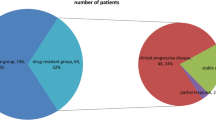Abstract
Recently, microRNA-99 family members, such as miR-99a/b and miR-100, have been reported to exhibit abnormal expression in various malignant tumors, but their functions in carcinomas are controversial. In this study, we focused on miR-99a and miR-100, which were determined to be universally downregulated in esophageal squamous cell carcinoma, and investigated their functions and potential mechanisms of action. The downregulation of miR-99a/100 was validated by qRT-PCR in 101 ESCC surgical tissue samples and in 3 ESCC cell lines. The overexpression of miR-99a and miR-100 via the transient transfection of the corresponding precursor molecules inhibited cell proliferation by inducing apoptosis in the ESCC cell lines. To investigate the molecular mechanism of miR-99a/100-induced apoptosis, luciferase reporter assays and Western blots were performed to demonstrate that the overexpression of miR-99a/100 suppressed the expression of mTOR by directly targeting its 3′UTR in a post-transcriptional manner. Clinically, the decreased expression of miR-99a/100 was associated with worse overall survival in ESCC patients. In conclusion, these results indicated that miR-99a and miR-100 inhibited cell proliferation by suppressing mTOR in ESCC cell lines, and therefore, the miR-99a/100-mTOR signaling pathway is a potential therapeutic target for inducing apoptosis to combat ESCC.




Similar content being viewed by others
References
Jemal A, Center MM, DeSantis C, Ward EM. Global patterns of cancer incidence and mortality rates and trends. Cancer Epidemiol Biomarkers Prev. 2010;19:1893–907.
Ferlay J, Shin HR, Bray F, Forman D, Mathers C, Parkin DM. Estimates of worldwide burden of cancer in 2008: GLOBOCAN. Int J Cancer. 2008;127(2010):2893–917.
Bosetti C, Levi F, Ferlay J, Garavello W, Lucchini F, Bertuccio P, Negri E, La Vecchia C. Trends in oesophageal cancer incidence and mortality in Europe. Int J Cancer. 2008;122:1118–29.
Corley DA, Buffler PA. Oesophageal and gastric cardia adenocarcinomas: analysis of regional variation using the Cancer Incidence in Five Continents database. Int J Epidemiol. 2001;30:1415–25.
Tran GD, Sun XD, Abnet CC, Fan JH, Dawsey SM, Dong ZW, Mark SD, Qiao YL, Taylor PR. Prospective study of risk factors for esophageal and gastric cancers in the Linxian general population trial cohort in China. Int J Cancer. 2005;113:456–63.
el-SeragH.B The epidemic of esophageal adenocarcinoma. Gastroenterol Clin North Am 31 (2002) 421-440.
Terry P, Lagergren J, Ye W, Nyren O, Wolk A. Antioxidants and cancers of the esophagus and gastric cardia. Int J Cancer. 2000;87:750–4.
Risk JM, Evans KE, Jones J, Langan JE, Rowbottom L, McRonald FE, Mills HS, Ellis A, Shaw JM, Leigh IM, Kelsell DP, Field JK. Characterization of a 500 kb region on 17q25 and the exclusion of candidate genes as the familial tylosis oesophageal cancer (TOC) locus. Oncogene. 2002;21:6395–402.
He L, Hannon GJ. MicroRNAs: small RNAs with a big role in gene regulation. Nat Rev Genet. 2004;5:522–31.
Bartel DP. MicroRNAs: genomics, biogenesis, mechanism, and function. Cell. 2004;116:281–97.
Laplante M, Sabatini DM. mTOR Signaling in growth control and disease. Cell. 2012;149:274–93.
Yang Z, Klionsky DJ. Eaten alive: a history of macroautophagy. Nat Cell Biol. 2010;12:814–22.
Um SH, Frigerio F, Watanabe M, Picard F, Joaquin M, Sticker M, Fumagalli S, Allegrini PR, Kozma SC, Auwerx J, Thomas G. Absence of S6K1 protects against age- and diet-induced obesity while enhancing insulin sensitivity. Nature. 2004;431:200–5.
Guo Y, Chen Z, Zhang L, Zhou F, Shi S, Feng X, Li B, Meng X, Ma X, Luo M, Shao K, Li N, Qiu B, Mitchelson K, Cheng J, He J. Distinctive microRNA profiles relating to patient survival in esophageal squamous cell carcinoma. Cancer Res. 2008;68:26–33.
Zheng YS, Zhang H, Zhang XJ, Feng DD, Luo XQ, Zeng CW, Lin KY, Zhou H, Qu LH, Zhang P, Chen YQ. MiR-100 regulates cell differentiation and survival by targeting RBSP3, a phosphatase-like tumor suppressor in acute myeloid leukemia. Oncogene. 2012;31:80–92.
Varnholt H, Drebber U, Schulze F, Wedemeyer I, Schirmacher P, Dienes HP, Odenthal M. MicroRNA gene expression profile of hepatitis C virus-associated hepatocellular carcinoma. Hepatology. 2008;47:1223–32.
Chen Z, Jin Y, Yu D, Wang A, Mahjabeen I, Wang C, Liu X, Zhou X. Down-regulation of the microRNA-99 family members in head and neck squamous cell carcinoma. Oral Oncol 2012.
Panarelli NC, Chen YT, Zhou XK, Kitabayashi N, Yantiss RK, MicroRNA expression aids the preoperative diagnosis of pancreatic ductal adenocarcinoma. Pancreas (2012).
Huang L, Lin JX, Yu YH, Zhang MY, Wang HY, Zheng M. Downregulation of Six MicroRNAs Is Associated with Advanced Stage. Lymph node metastasis and poor prognosis in small cell carcinoma of the cervix: plos one. 2012;7:e33762.
Petrelli A. Perra A. Schernhuber K. Cargnelutti M. Salvi A. Migliore C. Ghiso E. Benetti A. Barlati S. Ledda-Columbano GM. Portolani N. De Petro G. Columbano A. Giordano S. Sequential analysis of multistage hepatocarcinogenesis reveals that miR-100 and PLK1 dysregulation is an early event maintained along tumor progression. Oncogene (2012).
Yang Z, Klionsky DJ. Mammalian autophagy: core molecular machinery and signaling regulation. Curr Opin Cell Biol. 2010;22:124–31.
Li D, Liu X, Lin L, Hou J, Li N, Wang C, Wang P, Zhang Q, Zhang P, Zhou W, Wang Z, Ding G, Zhuang SM, Zheng L, Tao W, Cao X. MicroRNA-99a inhibits hepatocellular carcinoma growth and correlates with prognosis of patients with hepatocellular carcinoma. J Biol Chem. 2011;286:36677–85.
Grundmann S, Hans FP, Kinniry S, Heinke J, Helbing T, Bluhm F, Sluijter JP, Hoefer I, Pasterkamp G, Bode C, Moser M. MicroRNA-100 regulates neovascularization by suppression of mammalian target of rapamycin in endothelial and vascular smooth muscle cells. Circulation. 2011;123:999–1009.
Acknowledgments
This study was supported by the Chinese National Natural Science Foundation Grants 30971463 and 81172336, the International Science and Technology Corporation and Exchange Project Grant 2010DFB30650, the Key Technologies R & D Program Grants 2012AA02A502, 2012AA02A503 and 2012AA02A207, and the Doctoral Fund of Ministry of Education of China Grant 20091106110031.
Author information
Authors and Affiliations
Corresponding author
Electronic supplementary material
Below is the link to the electronic supplementary material.
Rights and permissions
About this article
Cite this article
Sun, J., Chen, Z., Tan, X. et al. MicroRNA-99a/100 promotes apoptosis by targeting mTOR in human esophageal squamous cell carcinoma. Med Oncol 30, 411 (2013). https://doi.org/10.1007/s12032-012-0411-9
Received:
Accepted:
Published:
DOI: https://doi.org/10.1007/s12032-012-0411-9




